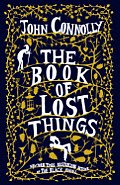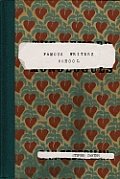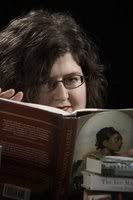
Random House is the distributor for some of my favourite UK imprints; most notably Harvill Secker and Chatto & Windus. They also have a number of other important imprints. So with a period covering 6 months, it shouldn't be surprising that my picks comprise such a long list.
I haven't had a close look at their non-fiction offerings, so this list is mostly adult fiction. A number of notable books are being released in trade paperback over the next few months and, for those I listed as picks last summer, I've included them here again.
Note: Books marked with the "%" symbol are books I reviewed in hardcover. The link will take you to the blog entry of my review.
 Anchor
Anchor*
The Day Watch by Sergei Lukyanenko (January 30, 2007)
*
The Unbinding by Walter Kirn (January 30, 2007)
*
The Mysterious Secret of the Valuable Treasure: Curious Stories by Jack Pendarvis (February 6, 2007)
*
Poppy Shakespeare by Clare Allan (Trade Paperback, April 10, 2007)
*
The Attack by Yasmina Khadra (May 8, 2007)
*
The Stolen Child by Keith Donohue (Trade Paperback, May 8, 2007) %
Ballantine Books*
Blood of Paradise: a Novel by David Corbett (March 6, 2007)
*
Damsels Under Stress by Shanna Swendson (May 1, 2007)
*
Summer Reading by Hilma Wolitzer (May 22, 2007)
*
The Sonnet Lover: a Novel by Carol Goodman (June 12, 2007)
 Bantam
Bantam*
Sixty Days and Counting by Kim Stanley Robinson (February 27, 2007)
*
The Hindi-Bindi Club: a Novel with Recipes by Monica Pradhan (May 1, 2007)
Bond Street Books*
The Reluctant Fundamentalist by Mohsin Hamid (April 24, 2007)
Broadway Books*
French by Heart: An American Family's Adventures in La Belle France by Rebecca S. Ramsey (April 24, 2007)
*
The Book of Jane by Anne Dayton & May Vanderbilt (June 12, 2007)
Chatto & Windus*
Death of a Salaryman by Fiona Campbell (April 27, 2007)
Crown*
The Secret Magdalene: a novel by Ki Longfellow (March 27, 2007)
*
Adventures of an Italian Food Lover: With Recipes from 213 of My Very Best Friends by Faith Willinger (April 3, 2007)
*
The Five-Forty-Five to Cannes by Tess Uriza Holthe (May 8, 2007)
*
Plenty: One Man, One Woman, and a Raucous Year of Eating Locally by Alisa Smith and J.B. MacKinnon (May 15, 2007)
*
Deer Hunting with Jesus: Dispatches from America’s Class War by Joe Bageant (June 12, 2007)
*
Mary Modern: a Novel by Camille Deangelis (July 10, 2007)
*
The Water's Lovely: a Novel by Ruth Rendell (July 17, 2007)
 Del Rey
Del Rey*
Ink: the Book of All Hours by Hal Duncan (February 27, 2007)
*
The Music of Razors by Cameron Rogers (May 1, 2007)
*
Maledicte by Lane Robins (May 29, 2007)
Delacorte Press*
The Blood Spilt by Åsa Larsson (January 30, 2007)
*
All Saints by Liam Callanan (February 27, 2007)
Dial Press*
Send Me by Patrick Ryan (January 30, 2007)
*
Paradise Park by Allegra Goodman (Reissue, March 17, 2007)
*
Cellophane by Marie Arana (May 1, 2007)
*
The Archivist's Story by Travis Holland (May 1, 2007)
 Doubleday Canada
Doubleday Canada*
Overture: a Novel by Yael Goldstein (January 16, 2007)
*
The End of the Alphabet by CS Richardson (January 23, 2007)
*
Death Comes For the Fat Man: A Dalziel and Pascoe Mystery by Reginald Hill (March 6, 2007)
*
The Color of a Dog Running Away by Richard Gwyn (March 20, 2007)
*
Rant: The Oral History of Buster Casey by Chuck Palahniuk (May 1, 2007)
*
Three Bags Full by Leonie Swann (June 5, 2007)
*
The Night Ferry by Michael Robotham (June 12, 2007)
Harvill Secker*
Montano by Enrique Vila-Matas (January 23, 2007)
*
Nada by Carmen Laforet (February 27, 2007)
Knopf*
Adam Haberberg by Yasmina Reza (January 2, 2007)
*
A Handbook to Luck by Cristina Garcia (April 10, 2007)
*
The Ministry of Special Cases by Nathan Englander (April 24, 2007)
 Little Bookroom
Little Bookroom*
Literary St. Petersburg by Elaine Blair (May 1, 2007)
Nan A. Talese*
The Fabric of Night: A Novel by Christoph Peters (January 9, 2007)
*
Delirium by Laura Restrepo (March 20, 2007)
*
The Sirens of Baghdad: a Novel by Yasmina Khadra (May 8, 2007)
NYRB Classics*
That Awful Mess on the Via Merulana by Carlo Emilio Gadda (Reissue, February 27, 2007)
*
Enchanted April by Elizabeth von Arnim (Reissue, April 3, 2007)
*
The Slynx by Tatyana Tolstaya (Reissue, April 17, 2007)
 Random House
Random House*
Still Water Saints by Alex Espinoza (January 30, 2007)
*
Radiance by Shaena Lambert (February 13, 2007)
*
Absurdistan by Gary Shteyngart (Trade Paperback, April 3, 2007)
*
No Humans Involved by Kelley Armstrong (May 1, 2007)
*
A Death in Vienna by Frank Tallis (May 8, 2007)
*
Tom Bedlam: a Novel by George Hagen (June 5, 2007)
Shaye Areheart Books*
The Prince of Nantucket: a novel by Jan Goldstein (April 24, 2007)
*
A Good and Happy Child by Justin Evans (May 22, 2007)
Three Rivers Press*
The Moonlit Cage: A Novel by Linda Holeman (March 27, 2007)
*
13 Bullets: a Vampire Tale by David Wellington (May 22, 2007)
*
To Dance with Kings: a Novel by Rosalind Laker (May 22, 2007)
*
Dark Angels: a Novel by Karleen Koen (May 29, 2007)
*
Wish Club by Kim Strickland (May 29, 2007)
*
Turning the Tables: A Novel by Rita Rudner (June 26, 2007)
Vertical*
The Cat in the Coffin by Mariko Koike (June 5, 2007)
Villard*
There's a Slight Chance I Might be Going to Hell by Laurie Notaro (May 29, 2007)
 Vintage Canada
Vintage Canada*
The Brief History of the Dead by Kevin Brockmeister (Trade Paperback, January 9, 2007)
*
Lost Echoes by Joe R. Lansdale (February 13, 2007)
*
The Truth About Sascha Knisch by Aris Fioretos (February 27, 2007)
*
The Lizard Cage by Karen Connelly (Trade Paperback, March 6, 2007)
*
The City of Dreaming Books by Walter Moers (Trade Paperback, March 27, 2007)
*
Giraffe by J.M. Ledgard (Trade Paperback, March 27, 2007)
*
Suite Francaise by Irene Nemirovsky (Trade Paperback, April 10, 2007)
*
The Dead Fish Museum by Charles D'Ambrosio (Trade Paperback, April 10, 2007) %
*
By the Time You Read This by Giles Blunt (Trade Paperback, May 8, 2007)
William Heinemann*
Nine Nights by Bernardo Carvalho (February 27, 2007)
*
Cupid's Darts by David Nobbs (March 27, 2007)
*
Forgotten Dreams by Katie Flynn (May 22, 2007)
*
A Most Dangerous Woman by Lee Jackson (May 22, 2007)
tags: books reading winter and spring books 2007 publishing Anchor Books Ballantine Books Bantam Books Bond Street Books Broadway Books Chatto & Windus Crown Del Rey Delacorte Press Dial Press Doubleday Canada Harvill Secker Knopf Little Bookroom Nan A. Talese NYRB Classics Random House Shaye Areheart Books Three Rivers Press Vertical Villard Vintage Canada William Heinemann
 Josephine Pickering has grown up on the highways of the United Kingdom, in her father Bobby's rig. Abandoned by his wife shortly after Jo’s birth, Bobby took to the road with his baby daughter. A Northern Irishman, Bobby was a country musician before he became a father and he passed his love of country music and the open road on to his daughter.
Josephine Pickering has grown up on the highways of the United Kingdom, in her father Bobby's rig. Abandoned by his wife shortly after Jo’s birth, Bobby took to the road with his baby daughter. A Northern Irishman, Bobby was a country musician before he became a father and he passed his love of country music and the open road on to his daughter.



















